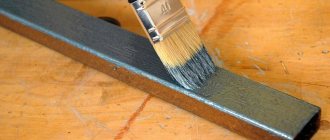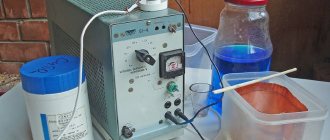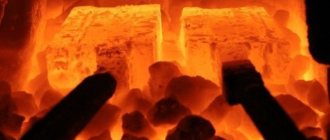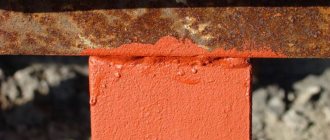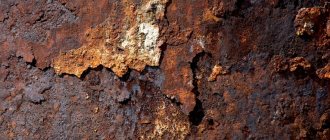The choice of paint and varnish material involves assessing the characteristics of the material that will be painted in order to provide additional protection and decorative design after completion of the work. In order to create a reliable barrier from external factors, silver paint is often used, which also looks impressive. It is popular to apply serebro color to metal surfaces, but many compositions can be used on wood, glass, fabric and other materials. The specifics of choosing and working with silver paint will be discussed in detail below.
Composition and properties
Despite the name, this paint does not contain silver. It is made from aluminum powder. The resulting metal dust is diluted with a thickener.
Properties of silver for painting metal:
- After application, a durable metal film is formed on the painted surface. It protects the material from the destructive effects of moisture and chemicals.
- Protects against exposure to ultraviolet rays. Painted surfaces do not heat up in the sun.
- The surfaces are leveled, the texture becomes pleasant to the touch.
You can buy the dye at any construction market. Additionally, you will need varnish or drying oil.
Types and form of release
On sale you can find two types of silverware, which differ in the production method and properties:
- Heat resistant paint. Finished products obtained by mixing bitumen varnish and aluminum powder. The coloring composition is resistant to high temperatures. The layer maintains its integrity when heated to 400°C.
- Classic silver. It is suitable for application to wooden and concrete surfaces. Does not withstand high temperatures. Not suitable for application to the surfaces of radiators and heating pipes.
Heat-resistant silver paint for metal is used for various purposes:
- painting batteries;
- painting metal pipes;
- protecting metal from overheating and moisture.
It is often used for painting metal household products. On sale you can find both ready-made formulations and powder in packages that need to be diluted.
Batteries painted silver
Silver paint - what does it mean?
Silver paint got its name due to its external resemblance to this metal, but the material itself is not used in the composition; usually, aluminum powder or its smallest particles are introduced to give a metallic glow.
For artistic paints, special powder can be used; the building compositions contain solvents to create a liquid state, which also help improve the technical characteristics of the layer.
There are aerosols on sale that are convenient for spreading a layer of paint over a surface, resulting in a thin and even coating that dries quickly. Spray cans are often chosen for processing automotive parts.
Silver paint got its name due to its external resemblance to this metal.
Features, what number in the palette
Silver paint is present in palettes of various compositions. But the tone is usually not included in the standard palette. Most often it is present in an expanded palette and is added with a golden color. Silver acrylic paint may have a different number from different manufacturers, it all depends on the chosen designation in production.
To simplify the choice, manufacturers compile a catalog where the numbering of shades is indicated. In this case, there may be several shades of silver from light to dark; such diversity makes it possible to choose the right option for the task at hand without difficulty.
Also on sale are special silver colors, which are added to the base color composition and give the desired metallic effect to the coating.
Most often it is present in an expanded palette and is added with a golden color.
Advantages and disadvantages
Pros:
- withstands high temperatures;
- holds firmly to the base;
- suitable for coating concrete, wood, metal;
- dries quickly after application;
- does not emit harmful substances.
Minuses:
- The powder is explosive. It should not be stored in direct sunlight or near flame sources.
- Quickly absorbs food odors.
If you apply silver to nitro enamel or NBCH paint, it will not last for a long time.
Pros and cons of silver
People have been using silver paint for more than a century, and during this time no one has had time to get tired of the paint. On the contrary, it is used more and more often for various needs. What is the secret of such popularity? It's all about the huge number of advantages it has:
- Silver does not flake and is quite durable and at the same time thin material. But at the same time, if you need to, you can easily get rid of the paint.
- The paint turns into a protective layer for the surfaces it is applied to. It creates a thin but even, smooth layer, fully displaying the surface texture.
- It is used on various materials - from wood to concrete and metal.
- Long service life, so the paint does not deteriorate in water for 3 years, nominally about 7 years, but in reality even longer.
- Not afraid of high temperatures.
- Invulnerable to corrosion.
- Non-toxic.
- Dries quickly.
- Painted in a pleasant silver color.
- With its help, you can achieve different shades of metal using pigments.
Of course, in addition to its advantages, this paint has its disadvantages, the main one of which is the risk of explosion. Therefore, such powder should be stored in a dry place and in a tightly sealed container, away from possible sources of fire and direct sunlight. You should not keep the paint near food, as the silverfish smell will quickly be absorbed.
It is also worth noting that the paint is incompatible with oil and alkyd paints. In addition, silver should not be applied on top of NBC and nitro-enamel paints, since in combination with such a coating the paint will not last long on the surface, will quickly come off and, possibly, swell with bubbles.
Preparation and breeding
If silver metal paint was purchased in powder form, it must be prepared before application. Varnish or drying oil is suitable for diluting the dye. When choosing the second option, you need to buy only synthetic fluid.
After purchasing a liquid for diluting silverfish, you need to learn how to properly mix the dye components. Features of paint thinning PAP-1:
- Prepare varnish BT-577. Mix it with silver powder in a ratio of 5 to 2.
- When mixing components, use a mixer set to low speed.
The resulting composition can be applied to radiators and heating pipes. It can withstand heat up to 400°C.
Features of paint dilution based on PAP-2:
- Any varnish is suitable for mixing this type of silver powder.
- Mixing proportions: 3-4 parts varnish, 1 part silver.
- When making a coloring composition, you need to constantly stir the solution.
The resulting paint will be very thick. Before applying it to a metal surface, you need to wait 10-15 minutes.
To apply the finished coloring composition you can use:
- synthetic brushes;
- spray;
- roller
Attention should also be paid to preparing metal surfaces before applying paint. To do this, you need to perform several steps:
- Clean the surface with a metal brush.
- Sweep away the dust with a broom or sponge.
- Remove rust using special chemical compounds.
Preparing the Paint
Application principles
Coloring principle:
- Prepare the metal surface, degrease it with a solvent.
- Wait until the solvent dries, mix the dye.
- Apply a layer of primer to the prepared surface.
- Wait until the soil dries, apply silver to the metal.
If you need to reliably protect the metal from exposure to water or chemicals, you need to paint it with silver in three layers. When applying new layers, you need to wait until the previous one dries.
Silver painting - reasons for popularity
The use of silverfish is widespread, it is used both for domestic purposes and in industry. Due to its protective and decorative properties, it is used to cover machine parts, pipes and bridges.
It doesn’t have to be used only on metal surfaces; it can also successfully paint wood. It includes aluminum powder and varnish, and you can add different pigments.
Its composition is quite simple, but it has properties that are not found in other paints and varnishes:
- the layer turns out uniform, smooth, the film is thin and does not peel off;
- service life in air – 7 years, in water – 3 years;
- the surface turns out beautiful and decorative (by adding pigment you can get not only a silver color);
- resistant to corrosion;
- dries quickly.
Of course, like any material, it also has disadvantages, which, in principle, do not affect the properties of the coating in any way. The powder is flammable (with the possibility of explosion), so it should be stored away from sources of fire and in a tightly closed container.
Video: How to paint with silver powder
Wash
During operation, paint may get on surrounding objects. To prevent this, you need to cover the surrounding surfaces with plastic film.
If paint gets on the floor or walls, it can be washed off in several ways:
- Place a few drops of sunflower oil on the painted area. Wait 10–15 minutes. Wipe the surface with any dry cloth.
- Buy nail polish remover without acetone. Apply it to the stain with a brush. Wait 5 minutes. The paint will become wet and cracks will appear. Wipe off the stain with a rag. Wash off any remaining nail polish remover with plenty of water.
When working with silverfish, you need to wear a work uniform, gloves, safety glasses, and a respirator. They will protect the respiratory tract, eyes and body from metal dust.
Silver paint has not lost popularity for several decades. This is due to its unique properties and low price. In order for the painted surface to maintain high strength and an attractive appearance, you need to take into account some nuances when preparing and applying the coloring composition.
What is silver paint and does it have a silver color?
New technologies make it possible to add silver nanoparticles to the coloring composition, which have a protective bactericidal function. In this case, silver particles are not used to impart the desired color, but have a completely different effect on the composition. To make the layer silver, it will be necessary to introduce too many particles, which is impractical.
If required, you can purchase silver paint with silver in the composition, but the palette also includes other shades.
New technologies make it possible to add silver nanoparticles to the coloring composition, which have a protective bactericidal function.
Is the bactericidal effect real?
Silver nanoparticles, as proven by scientists when painting surfaces, actually have a bactericidal effect. But if we are talking about covering walls, then it will not be enough to paint only one wall in a room with similar paint; you will need to cover a large area. Therefore, to achieve the effect, all walls are painted.
Such painting can be done in medical institutions, schools, as well as in residential buildings and apartments. It is acceptable to paint children's rooms; the composition does not cause harm, but rather serves as additional protection. There are compositions for interior and exterior painting.
The products are produced with the necessary quality certificates, they are protected by a patent; you should request the relevant documents when purchasing.
To achieve the effect, all walls are painted.
Silver paint creates an unusual metallic effect on the surface and can be used to paint walls, ceilings, and individual objects. Suitable for various materials, not just metal. When choosing, the operating conditions are taken into account in order to create the necessary barrier from external influences. Silver on the surface looks beautiful and stylish.
